Top News
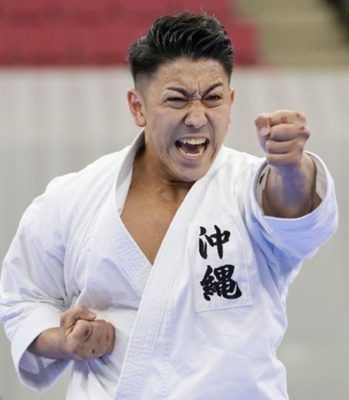
December 13, 2020 Ryukyu Shimpo
Ryo Kiyuna (Ryueiryu-ryuhokai) set a record in capturing his ninth straight Emperor’s Cup in the men’s kata at the 48th All-Japan Cup Karatedo at the Nippon Budokan in Tokyo on December 13. This title breaks the record set by Ryoki Abe between 1992 and 1999. Kiyuna faced off against Kazumasa Moto (AGP) in the final round, and came out victorious after receiving a score of 28.74 for his stunning performance of the Anan kata. Moto would finish in second a 1.14 points behind.
In the preliminary round Kiyuna performed the Seipai kata for a score of 26.10, and in the second round he performed the Kururunfa, with both scores putting him in first place heading into the ranking round. In the ranking round he performed Ryueiryu’s Paiku kata for a score of 27.86, making him the only performer to top 27 points and sending him to the championship round in the top spot.
Iwamoto Emiri (Clean Corporation), who trains at Ryueiryu-ryuhokai along with Kiyuna, won the third place match after scoring a 26.02 for her performance of the Papuren kata. In the preliminary rounds she scored 25.60 for the Seipai and 25.54 for the Kururunfa, and proceeded to the ranking round in second place. However, during that round she came up just short with her Anan kata with 26.22, narrowly missing a spot in the championship bout.
Arata Kinjo (Ryueiryu-ryuhokai) took fifth place in the Men’s kata after scoring 23.18 for his Seipai and 22.85 for his Kururunfa in the preliminary rounds, missing a chance to proceed to the ranking round.
In the kumite, Kota Miyazato (Japan Self Defense Forces) was eliminated in the second round, and Rika Kinjo (Nippon Sport Science University, third year) was eliminated in the first round.
(English translation by T&CT and Sam Grieb)
Go to Japanese
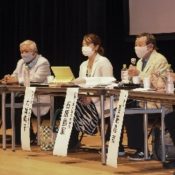
December 13, 2020 Ryukyu Shimpo
As the 50th anniversary of the 1970 Koza Riot on December 20 approaches, the Okinawa Asia International Peace Art Project 2020 Steering Committee and the Ryukyu Shimpo held a “Symposium for Asking Questions on the 50th Anniversary of the Koza Riot” on December 13 at the Ryukyu Shimpo Hall in Izumizaki, Naha. Speakers Masaie Ishihara (Okinawa International University professor emeritus), Shoko Oshiro (Okinawa International University part-time instructor), Shokichi Kina (musician), and Jimmy Schwartz(former high commissioner specialist 1st class) discussed the significance of the Koza Riot and other matters. Around 150 people attended the symposium.
Professor Ishihara first redefined the event based on newspaper articles from the day it occurred and several days following, describing it as not a riot by the masses but “more appropriately as a ‘Koza anti-U.S.-military citizen’s uprising’”, and then stated, “it was a day that people restored their pride as human beings, and amidst the fires was a liberated people’s zone.”
Professor Oshiro discussed the words used by news reporters and scholars and pointed out that “‘riot’ and ‘unrest’ are words used by the rulers.” She then explained, “we should think about how to translate in present-day terms.”
Schwartz discussed his own upbringing and described his complicated state of mind, saying, “as both an Uchinanchu and an American, I felt torn.” He explained that he went to observe the scene by car with James B. Lampert, then the high commissioner of the United States Civil Administration of the Ryukyu Islands (USCAR). “[The high commissioner] didn’t say anything, but being in the position of someone responsible, I think he felt pained,” said Schwartz, recalling the experience.
Kina said, “what was the energy present at that time? It was the closest energy to independence we’ve felt. We’ve reached the time to think about the reversion movement and our identity.”
A viewing of video footage captured at the time of the riot and a performance by Kina were held prior to the symposium.
(English translation by T&CT and Sandi Aritza)
Go to Japanese
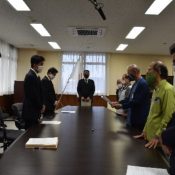
December 14, 2020 Ryukyu Shimpo
On December 1, Shokichi Yokota, chair of the Yomitan Village Makibaru Community Association, Kantoku Teruya, member of the House of Representatives, and Yomitan Village Mayor Denjitsu Ishimine, visited the Okinawa Defense Bureau Director-General Toshinori Tanaka. The group requested that the fence in front of the Chichen Utaki, a place of worship located inside the U.S. Army’s Kadena Ammunition Depot, be moved back toward the base so that the former residents of Makibaru village can visit and worship freely. The former Makibaru village was seized by the U.S. after the war; Still, in the past, the gate provided locals free access to the Utaki, and people visited to pray and dance eisa for the annual lunar festival on September 9. However, the gate was closed after the September11 attacks in 2001.
Director-General Tanaka revealed that he has been coordinating with the U.S. military to move the fence since receiving Yokota’s request last October. Tanaka explained that “the U.S. military responded that [moving the fence] is very difficult at the moment from a security standpoint,” but indicated he would continue coordinations on the issue.
During the meeting, Yokota cited how locals used to be able to access the place of worship freely and said, “The association’s view is that we were dragged into the war because of national policy. As a result, our land and the right to pray were taken away. The government should take responsibility and negotiate the relocation of the fence.”
(English translation by T&CT and Monica Shingaki)
Go to Japanese
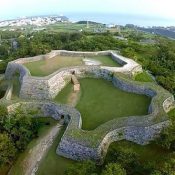
November 30, 2020 Ryukyu Shimpo
Nov 30 marks the 20th anniversary since nine sites throughout Okinawa were added to the United Nations Educational, Scientific and Cultural Organization’s World Heritage List as: “Gusuku and Related Heritage Sites of the Kingdom of Ryukyu.” The heritage sites are castles and utakis (Okinawan term for a sacred place), cultivated by the Ryukyu Kingdom’s unique culture and history. The seven municipalities where the World Heritage Sites are located are taking this occasion to improve the facilities near the sites to attract tourists and revitalize the community. Below, we look back on the 20 years of preserving and operating each of the sites and the challenges they face today.
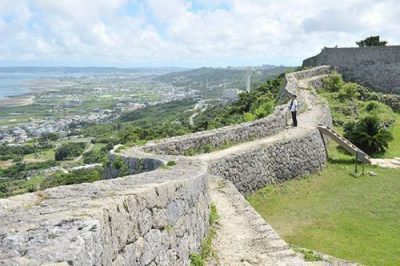
Nakagusuku Castle Remains in Tomari, Nakagusuku and Oshiro, Kitanakagusuku
The nine sites inscribed on the UNESCO World Heritage List are Nakijin Castle (Nakijin Village), Zakimi Castle (Yomitan Village), Katsuren Castle (Uruma City), Nakagusuku Castle (Nakagusuku Village and Kitanakagusuku Village), Shuri Castle (Naha City), Shikinaen (Naha City), Tamaudun (Naha City), Sonohyan-Utaki-Ishimon (Naha City), and Seifa-Utaki (Nanjyo City).
Each municipality is under pressure to improve its crisis management in excessive tourism, natural disasters, and the spread of infectious diseases, including the novel coronavirus.
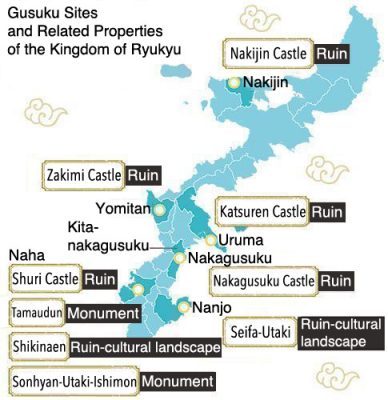
Traffic congestion caused by sightseeing buses was presenting challenges in the area surrounding Shuri Castle before it was ravaged by a fire last October. Similarly, Seifa-Utaki in Nanjo City welcomed around 30,000 visitors annually before it was added to the World Heritage List. In 2019, the number of visitors marked its highest record at about 470,000, according to the 2019 Tourism Handbook Prefectural Tourism Statistics, indicating the urgent need to address over-tourism.
Since the Seifa-Utaki and the Sonohyan-Utaki are religious monuments and are considered sacred, there are calls to conserve the natural environment surrounding them. Meanwhile, Nakijin Castle, which was partially destroyed in a typhoon, is currently being studied for restoration.
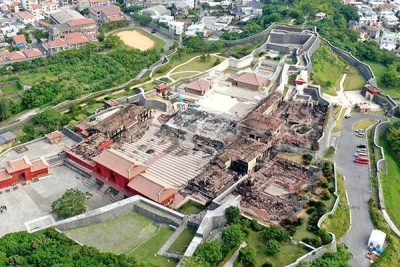
Shuri Castle was burned down in a fire on Oct 31, 2019. The underground structure located beneath the main hall is currently viewable from all directions through a protective glass installation.
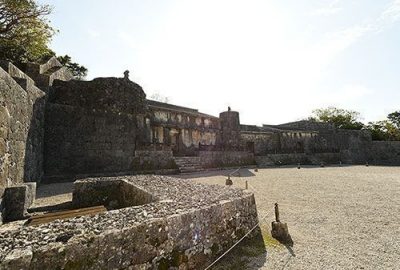
Tamaudun, in Shuri, Naha City
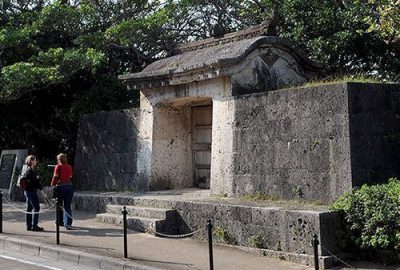
Sonhyan-Utaki-Ishimon in Shuri, Naha City
Disaster prevention Fire extinguishing measures added to Shuri Castle; preventing castle wall collapse
The October 2019 Shuri Castle fire destroyed its main hall, other reconstructed buildings, and damaged some of the underground structures, all of which were previously open to the public. In 2018, a section of Nakijin Castle’s stone wall collapsed during a typhoon. To uphold the historical and cultural significance of the World Heritage Sites, local governments are turning their attention to crisis management, including the COVID-19 pandemic, in addition to disaster and fire prevention.
■ Shuri Castle
After the Shuri Castle fire, the Japanese government took steps to protect what remained, and the grounds were reopened to the public in June this year. The reconstruction of the main hall will begin in the 2022 fiscal year and is scheduled for completion in 2026. Fire sprinkler systems, which were previously absent, will be added during the reconstruction work, and indoor fire hydrants will be upgraded; the corridors connecting the main hall to its surrounding buildings will be outfitted with fire shutters. Learning from the Shuri Castle fire, Naha City is re-examining its fire prevention measures for wooden structures elsewhere, such as the Shikinaen.
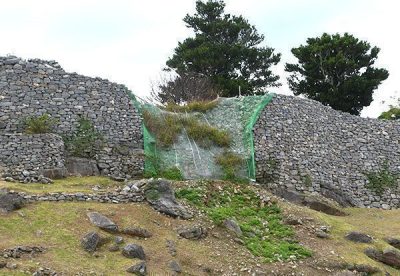
A net is placed over a section of Nakijin Castle’s stone wall, which collapsed during a 2018 typhoon (photographed on Nov 28, 2020).
Nakijin Castle’s stone wall was partially destroyed during a typhoon; its restoration is still under discussion, as the internal structure of the wall is currently under study. Steps have been taken to improve the durability of the stone wall, such as preemptively disassembling and reassembling sections of the wall that were at risk of collapsing. Yasushi Tamaki, head of the local Cultural Assets Department, said, “Dealing with a World Heritage property, our priority is to preserve its authenticity in order to convey the correct history of the site.”
■ Seifa-Utaki
The Nanjo City Tourism Association, together with the Amamikiyo Roman Guide Group (the group offers sightseeing tours of Seifa-Utaki), is providing its staff with lifesaving AED training. Additionally, as a precaution against the novel coronavirus pandemic, the association has also prohibited tourists from entering the sangui, the sacred triangular rock formation, to avoid the three C’s (crowded places, close-contact settings, and confined spaces).
The Nanjo City Commerce and Tourism Department normally closes the sites to visitors in a disaster, such as heavy rain. The secretary-general of the city’s tourism association, Hideki Yaga, said, “We want to raise awareness of disaster prevention in tourism in cooperation with the city, to better prepare for unexpected events such as earthquakes—not just heavy rain.”
Over-tourism Problems arise as tourism surge—tackling traffic congestion and parking space shortages
The World Heritage Sites throughout Okinawa saw a surge in tourism after they were inscribed on UNESCO’s list. Each municipality has made various efforts to meet the needs of its tourists. However, a conflict exists between preserving the local culture of revering the sites as sacred ground and preserving them as cultural property.
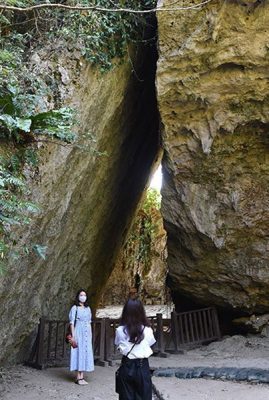
Gates were installed at the Seifa-Utaki to prevent visitors from entering the triangular rock formation known as the sangui located in Kudeken, Chinen, Nanjo City.
The status of Seifa-Utaki as a sacred ground has posed challenges for Nanjo City. Visitors to Seifa-Utaki reached 434,000 in 2013, causing traffic congestion for locals. Complaints were subsequently filed by residents as well as visitors whose primary purpose was to pray at Seifa-Utaki. In order to relieve traffic congestion, the city relocated the parking lot to the Nanjo City-Ganju Station. It also designated bi-annual closures (six days per year in total) to preserve the site’s historical and environmental characteristics. The Nanjo City Commerce and Tourism Department explained that it intends to safeguard the cultural property while promoting tourism without fixating too much on tourism statistics.
Hideki Yaga, secretary-general of the city’s tourism association, stressed, “We can add to Seifa-Utaki’s value as a ‘sacred place’ by protecting the site and its surrounding nature.”
■ Shuri Castle, Shikinaen, and Tamaudun
In the fiscal year 2018, about 2,806,000 visitors traveled to the national Shuri Castle park area, causing traffic congestion. One of the goals of rebuilding Shuri Castle is to design a community where tourists and residents can co-exist.
After the Shuri Castle fire, the number of visitors at Shikinaen and Tamaudun surged temporarily. In October 2019, the Shikinaen welcomed about 5,000 visitors, compared to 20,000 the following November, after the fire; the increased traffic damaged the site’s cobblestones.
Visitors dropped this year due to the pandemic. Still, Naha City Curator Yu Suzuki is thinking ahead: “We need to figure out the maximum number of visitors that will maintain a tranquil atmosphere.”
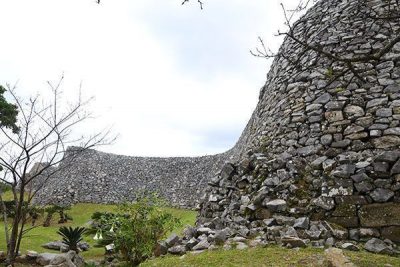
Nakijin Castle Ruins in Imadomari, Nakijin.
At the Nakijin Castle remains, the English translation of the information board is being revised. Yasushi Tamaki, the head of the Nakijin Cultural Assets Department, is confident that “[the new translation] will make Okinawa’s unique spiritual culture more intelligible.” More than half of the translation is complete.
■ Nakagusuku Castle
Nakagusuku Village, where Nakagusuku Castle is located, faces challenges in multilingualization, such as training tour guides to assist visitors from abroad. Furthermore, since there are no permanent exhibitions currently installed at Nakagusuku Castle, there is no way to communicate the significance of the gusuku (castle). The premises also lack parking space to accommodate guests during large scale events.
Enticing tourists Historical and cultural exhibits, events, and facility improvements
To further disseminate the appeal of the World Heritage Sites, each municipality has turned its attention to enticing tourists by improving nearby facilities. Events using projection mapping, in which images are projected onto the castle’s stone walls, are gaining popularity.
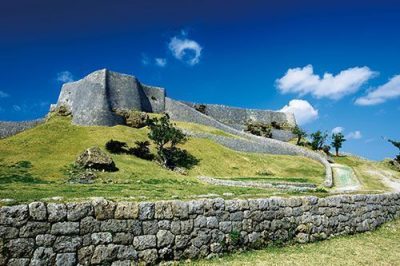
Katsuren Castle Ruins in Haebaru, Katsuren, Uruma City
The Katsuren Castle grounds is currently undergoing a major development project. Two facilities are scheduled to open across the street from the ruins: A facility containing restaurants and shops for local products, which will open in 2024, and a second dedicated to exhibits and displays.
The latter is slated to open its doors next summer, and will contain a theater equipped with a large screen. It will also house a permanent exhibit room to showcase the history and culture of Uruma City. The exhibit will allow visitors to learn about the city’s WWII battle sites and its history of bullfighting. Riki Kishimoto, head of the Uruma City Katsuren Castle Remains Maintenance Office, explained, “Photo and video footage, and cultural goods will be displayed to illustrate the histories of Katsuren Castle and the Ryukyu Kingdom.”
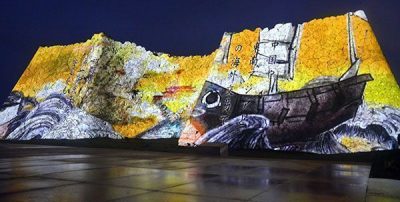
Nakagusuku Castle was one of the first heritage sites to hold a projection mapping event. Photographed in Nagakugusu Village in December 2013.
In Okinawa, Nakagusuku Castle has been the trailblazer in holding projection mapping and concert events. The site is equipped with a plaza that can hold up to 9,000 people, and utilizing the projection mapping events funded by the Okinawa Promotion Grant, it has gradually gained recognition since 2013.
Although the pandemic poses new challenges for holding events, the Nakagusuku Village Industrial Promotion Division representative is hopeful: “Since it is an outdoor event, we can still engage guests if we can market [the event] as a place to see the ruins while taking coronavirus precautions.”
■ Shuri Castle
At the end of October this year, the prefectural government also employed projection mapping at Shuri Castle, to add momentum to the reconstruction work. However, some visitors were seen climbing onto the Sonohyan-Utaki-Ishimon in an attempt to take photos of the projection. UNESCO recognized the utaki for having ties to the unique Ryukyuan religious beliefs. Naha City Curator Yu Suzuki said, “We hadn’t paid close attention to the spiritual aspects of the gusuku and its related heritage sites. We must protect the ruins themselves, but we should be maintaining an environment that is appropriate for religious symbols.”
■ Zakimi Castle
The Yuntanza Museum, located at the foot of the Zakimi Castle Remains, reopened in 2018 after undergoing renovations. Visitors can now learn about the castle ruins and the history, tradition, and culture of Yomitan Village. The museum has been well received by visitors from inside and outside the prefecture.
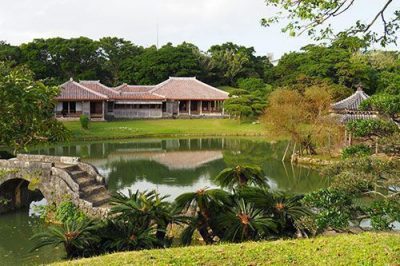
Shikinaen in Maaji, Naha City
The United Nations Educational, Scientific and Cultural Organization (UNESCO) selects and designates World Heritage Sites to protect cultural and natural heritage around the world considered to be of outstanding value. Once a site is inscribed on the World Heritage List by the World Heritage Committee, it receives various protection and assistance from the Heritage Fund. The pyramids in Egypt and the Great Wall of China are such sites. In Japan, 23 sites (as of July 2019) are listed, including Buddhist buildings in the Horyuji area of Nara Prefecture and the Atomic Bomb Dome in Hiroshima Prefecture.
(English translation by T&CT and Monica Shingaki)
Go to Japanese
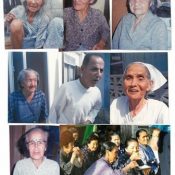
November 29, 2020 Ryukyu Shimpo
Miyakojima – “That old man boasts of being the strongest on the island.” “That old woman has the most exquisite singing voice.” The Ikema Culture Association (Tetsuya Kawakami, president) has published Sumabitu Retsuden (tales of the townspeople), a series of biographies that shines a spotlight on the various lives of the people on the island. The publication shares the stories and personal anecdotes of around 300 of the townspeople of Ikema Island in Miyakojima. Kawakami, 72, who heads the ICA, said, “The book is packed with the people and lives of Ikema. I would be very pleased if it led to a rediscovery of the charm of the island.”
Sumabitu Retsuden is 148 pages, and contains 12 chapters including, “Sumabitu stories passed down to today,” “Pioneers who protected and fostered the island,” “The insha (diver) who lived through it all,” and “The things that make the island proud.”
Kawakami compiled much of it by scrapbooking newspaper and magazine articles regarding the people of the island over around a 20-year period, as well as interviewing elderly residents of the island, collecting around 300 accounts of fascinating characters and accomplishments.
The table of contents is filled with catchy titles for the stories such as, “Masao Nakama, the face of the Ikema people,” “Iwao Okuhara, the man who lived in the sea, tells his tale of invulnerability,” and “Hide Yonamine, whose movements all become a painting.”
Kawakami, a former school principal, said of the chance to publish his work, “People are unique, and they are protagonists in their own dramas. I wanted to bring people together to leave behind each of their dramas in some form.”
To mark the publication date of November 21, a “Sumabito Retsuden discussion meeting,” was held at the Ikema Community Center. The gathering was attended by residents of the island, who had comments such as, “I could picture their faces in each of the episodes,” “I want to send it to my relatives living on Okinawa’s main island and other parts of Japan.” Ikema neighborhood council president Koji Nakama said, “It stays with you wonderfully. I want to pass this down as a treasure of the island.”
Sumabito Retsuden will have 300 copies printed for its initial publication, and can be purchased at the Ikema Cultural Association. For any inquiries, please contact Kawakami at (Tel.) 090 (7396) 6560.
(English translation by T&CT and Sam Grieb)
Go to Japanese

December 11, 2020 Ryukyu Shimpo
Around 8:00 a.m. a large-scale deck barge for storing soil for use in land reclamation work entered Oura Bay in Henoko, Nago City where Futenma Replacement Facility construction is moving forward. The deck barge was led to the bay by a tugboat, in the direction of Sedake, Nago City.
It is possible for the deck barge to continue depositing soil, without interruption, from an installed position. This is meant to speed up land reclamation work on the Henoko side of Cape Henoko.

The barge is 141 meters long and 36 meters wide. The Okinawa Defense Bureau (ODB) calls it a “deck barge”, and as much as 9,000 cubic meters of soil can be loaded upon it. Up to this point cargo ships carrying soil have been making repeated round trips stopping at Awa in Nago City, Shiokawa in Motobu Town, and then Oura Bay in Henoko. It is possible for the barge sit in Oura Bay holding several cargo ships’ loads worth of soil, making it possible to continue land reclamation work even on days when cargo ships carrying soil cannot enter the bay.
The plan is for the barge to lower an anchor in order to stay consistently anchored in the bay. In the past, the anchors for the silt curtains caused damage to the seafloor and coral when moved by stong winds. At the Environmental Oversight Committee meeting on November 17, the ODB announced changes to unloading methods. It appears that due to the installation of the barge and remodeling of the seawalls, it is likely there will be increased air pollutant emissions compared to current circumstances.
On November 30, the barge was installed outside of the seawall such that two cargo ships were able to come alongside the barge. In accordance with arranged preparations, the plan is to set similar barges at other seawalls.
(English translation by T&CT and Erin Jones)
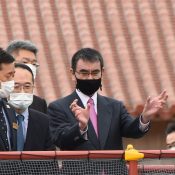
December 6, 2020 Ryukyu Shimpo
Taro Kono, the Minister of State for Administrative Reform and Okinawa, met with representatives from economic organizations as well as the mayors of Okinawa’s towns and cities in Naha on December 5, after arriving in Okinawa the previous evening, where they exchanged views on topics such as stimulating Okinawa’s industry, cultivating human resources, and childhood poverty. Kono indicated his plans to review prior and existing policies for stimulating Okinawa’s economy, and commented that with regards to Okinawa’s standing as the prefecture with the nation’s worst per-capita income, “I want to raise it up to 46th while I am in office.”
Prior to the meetings the minister also visited the remains of Shuri Castle, which was destroyed in a fire back in October, as well as the showroom for its reconstruction, emphasizing his support for the rebuilding process saying, “I would like to see the rebuilding be done properly without rushing. The government would like to see it rebuilt as a perfect backup copy of the original.”
This is Kono’s second visit to Okinawa since assuming the role of Minister for Okinawa. In addition to the progress of rebuilding Shuri Castle, he also observed Naha Airport’s coronavirus protocols, the U.S. military’s Naha Port Facility (Naha Military Port), as well as the military port’s new home after it is relocated to Urasoe.
At the meetings with Okinawan business leaders and mayors, they spoke about future economic development policies, saying, “we need to look at the data from the various subsidies and other projects up until now, and direct resources to where it will lead to results,” and reiterated his belief of verifying that the economic stimulus be based on effective policy.
(English translation by T&CT and Sam Grieb)
Go to Japanese
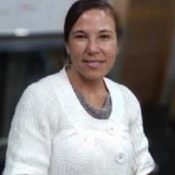
December 11, 2020 Ryukyu Shimpo
Nago – Hawaii-native Sarah Kobayashi has been teaching English to people in Nago, Okinawa for close to five years as an ALT (Assistant Language Teacher) and an instructor of English conversation classes. Now, students (represented by Yumiko Baba) in her English conversation classes, Aloha English Club in Nago, are asking for donations through an American crowdfunding site to support Sarah’s cancer treatment.
After working as a teacher at the Christian school in Yomitan, Sarah moved to Nago and taught English conversation. She was diagnosed with uterine cancer in January of this year. She returned to Hawaii to recuperate in November after her condition worsened.
Baba says, “Sarah Sensei has contributed so much to English education in Nago. I hope that the people of Nago can support her now.” The fundraising target is 5 million yen. The crowdfunding site “Faith for Sarah” can be accessed at the URL https://www.gofundme.com/f/faithforsarah/share. The site was created in the United States and is entirely in English. Donations are also being accepted via bank transfer. Transfers can be made through the Japan Post Bank using code 10150 and number 19013501. If depositing money by branch name, use the branch name 〇一八 (zero-ichi-hachi), to make an ordinary deposit to account number 1901350.
(English translation by T&CT and Ellen Huntley)
Go To Japanese
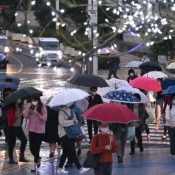
December 10, 2020 Ryukyu Shimpo
The Okinawa region has been experiencing cloudy skies since the beginning of December. The Okinawa Meteorological Observatory expects more cloudy and rainy days than usual for about a month between December 5 and January 4, 2021. The sunshine duration is expected to be about the same or lower than usual. High atmospheric pressures over the continent extending out to Okinawa and a trough of low atmospheric pressure are cited as factors.
On December 9, due to the weather front, six areas of Okinawa received the most rainfall for December on record, including Gusukube, Miyakojima City, which received 209.5 mm of rain. It also rained in Naha City, where people walked briskly with their umbrellas.
Due to the cold air and trough, the meteorological observatory predicts the cloudy and rainy weather will persist for another week.
(English translation by T&CT and Monica Shingaki)
Go To Japanese

December 3, 2020 Ryukyu Shimpo
Dave Roberts, manager of the 2020 World Series Champion Los Angeles Dodgers, a second-generation Okinawan born in Okinawa, has sent a message to Okinawa Prefecture stating, “Being an Okinawan is something I consider important.” The message was sent November 3 in response to a congratulatory letter sent by Okinawa Governor Denny Tamaki. He also noted his desire to meet for a discussion either in Okinawa or in the United States.
Governor Tamaki sent a letter to Roberts on October 29 after seeing the Dodgers win the World Series, saying, “Your spectacular achievement is an honor for Okinawans. Congratulations on [the Dodgers] first World Series championship in 32 years.” Roberts wrote back on November 3, replying, “Thank you for your support. When I come to Okinawa, or when you are in the United States, I would be honored to meet you.”
This information was provided by Okinawa Culture, Tourism, and Sports Bureau chief Kazuhiro Toguchi at a regular session of the Okinawa Prefectural Assembly in response to a question by Kenichiro Tamaki (TIDA net).
(English translation by T&CT and Sam Grieb)
Go To Japanese

December 2, 2020 Ryukyu Shimpo
On December 1, Professor Yasukatsu Matsushima of Ryukoku University presented a statement before the United Nations. In the statement, he sought the repatriation of ancestral remains removed from Okinawa in 1928-1929 by researchers at the former Imperial Universities. These remains have not yet been returned.
Matsushima presented virtually at meeting of the United Nations Expert Mechanism on the Rights of Indigenous Peoples held in Geneva, Switzerland. He presented as a joint representative of Nirai Kanai nu Kai, an Okinawan citizen’s group that is active in efforts to repatriate ancestral remains.
The statement was submitted jointly by Nirai Kanai nu Kai and the Shimin Gaikou Centre, an NGO that works with the United Nations. In the statement, the organizations criticize Kyoto University for not returning the ancestral remains kept at the university to Okinawa. Further, although the National Taiwan University returned the remains that were there, the Okinawa Board of Education that received them has rejected re-entombing. The organizations argue that this violates Article 12 of the Declaration on the Rights of Indigenous Peoples (the rights to religious traditions and customs, as well as repatriation of human remains). They also criticized research organizations for taking ancestral remains, keeping them, and using them for research. Additionally, the statement addressed the impact of the novel coronavirus, including the delay of oral arguments in the lawsuit seeking the return of the Ryukyuan remains (currently in litigation at the Kyoto District Court), saying “To a great extent, Covid-19 has limited the exercise of rights guaranteed by international law.”
(English translation by T&CT and Ellen Huntley)
Go to Japanese























 Webcam(Kokusai Street)
Webcam(Kokusai Street)


